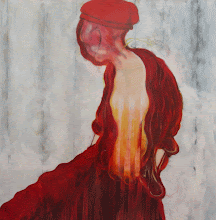
This model clarifies the 3 main areas of activity.
- Upper object area. Submitted objects will be placed on the Stave/Mesh according to instructions. Some may break the mesh and fall through. At a later stage a form will be set up to register place and impact of force.
- Stave/Mesh which will be changed dynamically from impacts upon it.
- Lower Object Area. Submitted objects here should be coloured according to Chromogenic bacteria palette (under construction).





Though a radical disruption to the proposed format, a vertical, rather than horizontal orientation of the stave and mesh would differentiate more clearly between objects falling onto it and objects striking it like blows or missiles on their trajectories. It would also allow the work to be viewed from the mesh side as well as the stave side, making the effect of the impacts more apparent - a dent on one side becoming a bulge on the other. Is the fulcrum and the concern for balance still as relevant as in the first game?
ReplyDeleteThe fulcrum acts as a 'leftover' from the original game. It might be knocked over. The stave might fall over as well. If all the objects fall from the stave the resulting musical score would be empty and silent.The music might then move to the bas clef where there is no formal 5 line signifier.
ReplyDeleteAustin john
If a vertical orientation were used, the fulcrum could act as a pivot, allowing the stave to swing in lateral arcs according to the forces applied to it.
ReplyDeleteI had imagined that the objects might become embedded in the mesh or the stave on impact, and therefore not fall off. [In practice this would mean attaching them.] However this would freeze each impact in time and isolate it from subsequent events, and thus limit potential for development.